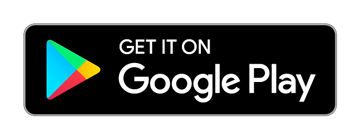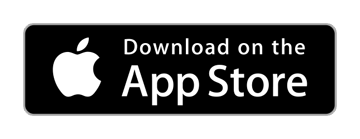Kaiser Permanente: Self-Care & Resilience
Our Mission is to empower people to operate more from the heart – both at work and in their personal lives.
Simple, practical, evidence-based tools: to manage the stress response in the moment, and create a collaborative and innovative team environment.
A strikingly different culture of genuine care: individuals build resilience and respond in new ways to change and emotional challenges with more presence, flow, flexibility and connection.
Valuable best practices developed over 20 years: to sustain engagement and achieve cultural shifts.
Return on investment with measurable outcomes: improvements in communication, teamwork, employee satisfaction, staff retention; reductions in sick time and health care claims costs.
Supports existing initiatives: easily integrated with existing wellness and performance improvement initiatives.
Case Studies
Click on a title bar, to reveal each organization’s goals and results:
Aerospace Company:
HeartMath has been delivered to over 2000 employees in different business units – for example: Leadership, Design, Production and Assembly. This case study is from a division that was experiencing a time of immense change and anxiety about future job security.
Goals
Under these challenging circumstances management wanted to help staff in this division relieve stress in relation to:
- Reduce staff tension and stress created by uncertainty and fast paced innovations
- Enhance self-care, creativity, ease and resilience
- Guide staff to become authentically present when providing care
Results – Personal/Health:
| Often/Most of the Time: | Pre | Post (45 days) |
|---|---|---|
| Angry | 18% | 4% |
| Exhausted | 31% | 14% |
| Tired | 46% | 21% |
| Anxious | 37% | 9% |
| Rapid heartbeats | 11% | 4% |
| Depressed | 15% | 5% |
| Sleeplessness | 24% | 13% |
What I thought was going to be a two hour break before a difficult project turned out to be one of the most useful classes that I have ever taken. Using the HeartMath techniques, I went back and successfully completed a difficult project which normally requires a half a day in just under an hour.
I had an appointment with my doctor, the day after the class, to check my blood pressure. It was better than any previous reading taken over the last 7 years. So far, I’m seeing excellent results.
Some see HeartMath as stress reduction. Some say it helps their family life and their productivity. Our focus was both cost and productivity. HeartMath gave our team the coherence we needed to come in under budget, on time, with productivity gains of up to 12%.
Global Oil Company:
Concerned about increasing levels of stress
within the organization; “Stress is very much a business issue … our line managers
have a responsibility for the health of their staff.”
Goals
Address employee stress in 9 different business units across Europe, Asia and Africa, to:
- Improve mental clarity
- Improve decision-making
- Reduce physical results of stress
Results for the first 500 people trained:
| Often/Most of the Time: | Pre | Post (6 wks) | Post (6 mos) |
|---|---|---|---|
| I feel exhausted | 39% | 22% | 18% |
| I feel worried | 35% | 16% | 12% |
| I feel angry | 18% | 9% | 6% |
| I experience sleeplessness | 21% | 13% | 10% |
| I have aches & pains | 30% | 16% | 12% |
| Agree/Strongly Agree: | Pre | Post (6 wks) | Post (6 mos) |
|---|---|---|---|
| I feel focused | 71% | 76% | 80% |
| We listen to each other | 49% | 58% | 62% |
The background physiology and the science underpinning this technique (HeartMath) are absolutely sound, which is why we went ahead with pilot studies here at our company. Seeing a self-induced change in their own heart rhythms impressed the company’s otherwise skeptical engineers.
Airline Industry:
A leader in corporate workplace wellness with a
track record for lowering healthcare costs. They recognized stress is a critical factor
to employee health and performance and contributes to rising health care costs.
Employees with 3 risk factors (Metabolic Syndrome):
Results produced reductions in:
|
59% |
|
20% |
|
26% |
Reductions in the number of participants with:
|
63% |
Employees clinical stress reduction:
Results from first 538 employees trained:
| Often/Always: | Pre | Post (10 weeks) |
|---|---|---|
| Fatigue | 30% | 12% |
| Anxiety/Depression | 10% | 04% |
| Inadequate sleep | 42% | 20% |
| Rapid heartbeats | 18% | 06% |
A second post measurement at the one-year mark showed sustained outcomes.
Comments from employees that completed the program:
Aware of my stress and feel I have the control to change the way I react to it.
My depression episodes are down by more than 50%. I am no longer taking medication and surprisingly feel better than before I started.
I sleep better. I have more energy. I don’t suffer so many body aches. I’m eating better.
Improved communication with my wife. I now have ways to deal with negative people at work.
I don’t have to take my heart pills because I don’t get a tightness in my chest anymore.
Silicon Valley Technology Company:
Retaining their high quality
engineers was a critical strategy for future growth and developing industry leadership
Workplace Effectiveness:
We are particularly pleased with improvements in the two metrics: ‘Our meetings at work are well organized’ – positive responses increased from 31% to 50% after 4 months; and ‘I feel like leaving this organization,’ which decreased from 28% to 16%.
Medium-sized hospital:
The CEO engaged HeartMath to transform the
hospital culture; staff experienced less stress, more resilience, and more satisfaction.
This caused a large decrease in health care claims costs.
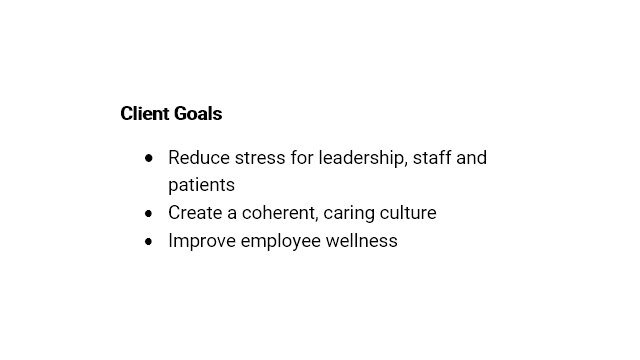
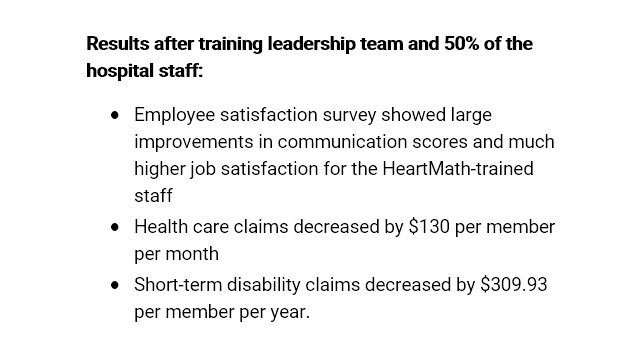
We have experienced very positive results from the use of HeartMath in our organization and realize the importance of incorporating HeartMath’s program into our culture. We continue to reach our goal of exceptional performance by lowering the stress of our employees, which increases the quality of care our patients receive and overall patient satisfaction.
Financial Institution:
Overview: The Leadership Center
implemented HeartMath tools with the executive team, district and branch managers,
customer service representatives, and sales staff to create a solid foundation for
their change management process and to introduce new strategies to their branch
network.

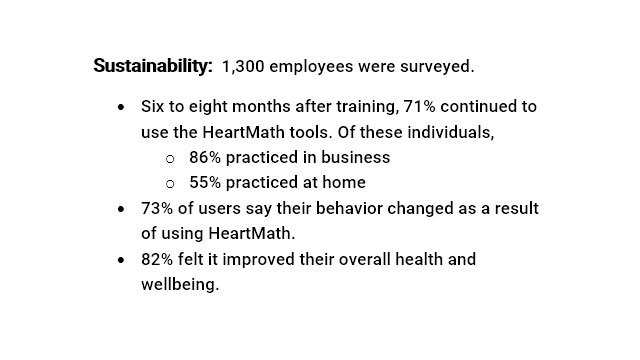
Personal Comments:
We are seeing that people feel more in control of their situation - not as reactive or overwhelmed. The employees who have taken the HeartMath training have experienced a shift in perspective about what’s going on around them, and have developed a more positive, energized, empowered outlook.
Luxury Hotels/Resort Group:
The General Manager brought in
HeartMath for a weekend retreat for his entire management team to address the stress
they were causing each other.
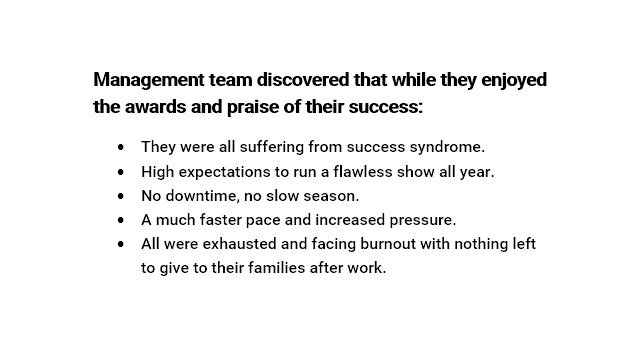
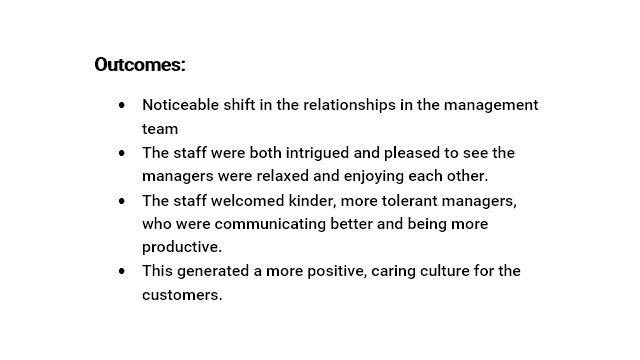
Comments:
Because the whole management team experienced the training together, their common experience laid a strong foundation for the organization. To bring similar benefits to the staff and integrate these practices into the organizational culture, two of the managers became certified to deliver HeartMath programs to the staff.
Telecommunications Company:
Improved employee health and
increased productivity were both critical strategies for future growth and
developing industry leadership.
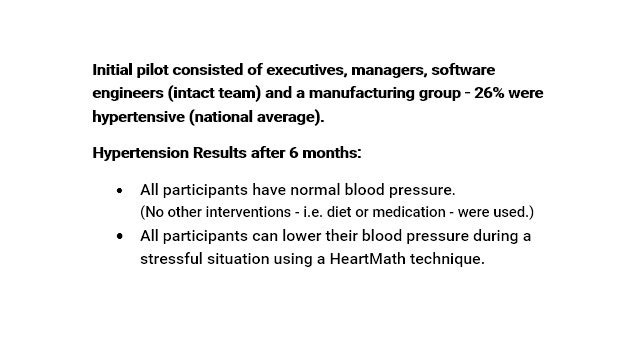
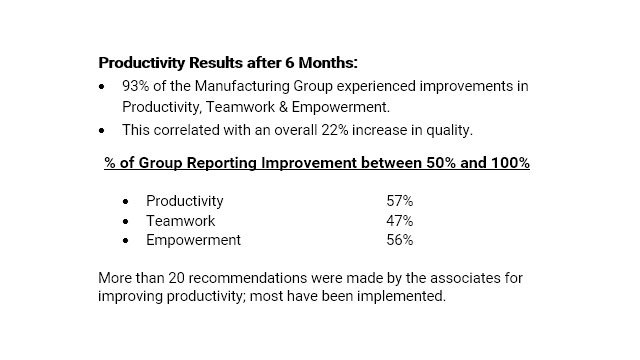
Participant Comments:
More inventions were disclosed in the last six months.
Since my stress levels are now lower, I am more relaxed and able to think more clearly. My negotiation skills have improved.
I’ve heard more positives on job satisfaction in one-on-one sessions and noted less conflict among people.
My number of patents per month literally doubled.
I feel more innovative in my approach to solutions. And, I can deal with stress much better than before.
It made me feel more empowered, like I can handle any problem. This course would benefit everyone from production to Board room.
Grocery-Pharmacy Company:
The VP Pharmacy was concerned with
managing incident rates (medication errors). A survey revealed that pharmacists
requested information on stress.
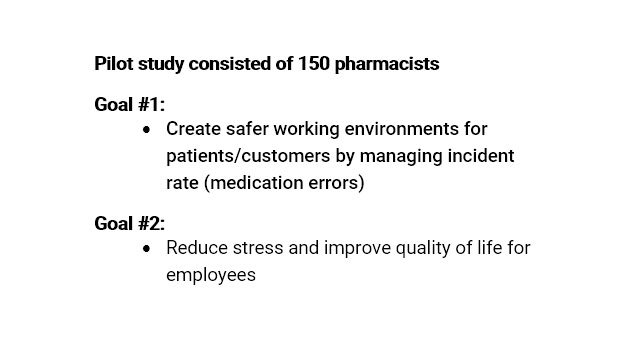

Participant Comments: “100% of participants reported ‘extremely satisfied’ with the HeartMath program.”
I am listening to people more, and am having less customer complaints. People are satisfied. When I am getting frustrated I take a quick timeout, and am ready to go. My stress levels have been reduced.
I can concentrate better. When I notice I’m hitting a stressor at work I can block it by using the techniques I’ve learned. And I don’t swear at traffic anymore on the way to work.
Thank you for providing this training! I am convinced that I will use these techniques forever.
Public Transportation System:
This company was undergoing
dynamic transformation, dealing with aggressive expansion goals, aging equipment
challenges, increasing customer demands and complaints, sensitive labor negotiations
and security concerns. Protecting the health of the talent pool was a priority.
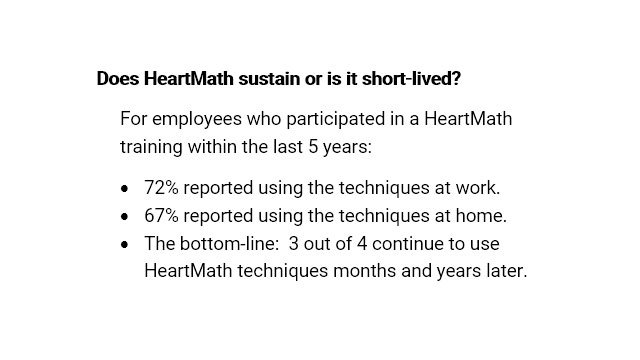
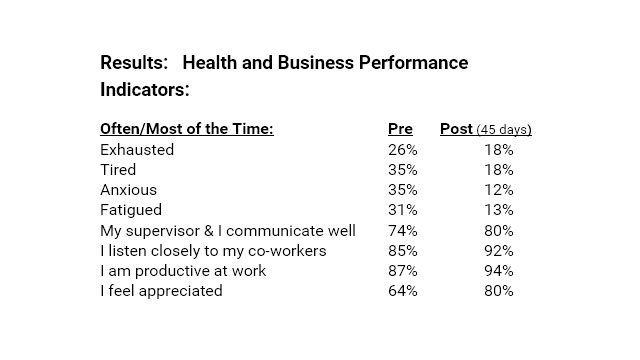
Comment:
Significant improvements were made in most categories of the personal well-being and stress reduction constructs. This is highly noteworthy, particularly considering the difficult conditions and pressures existing at this time.
Information Technology Division of a Large Healthcare Organization:
Recognizing the effects stress was having on the health of its
employees, the IT Division provided Inner Balance devices to help staff learn
meaningful stress reduction practices with the hope of decreasing negative long-term
effects of stress in the workplace. This effort evolved into a pilot project to see
if improvements were significant enough to purchase devices for the entire
organization.
Goals for the pilot project:
- Increase employee retention
- Increase employee engagement
- Increase employee productivity
We were shocked at the results, since the pilot group already had some of the highest employee retention percentages in the organization and employee engagement scores well above the National Healthcare Average. The pilot started two months before upgrading our electronic medical record and post survey results were literally taken during our final week of onsite support for the upgrade. From our perspective, that in and of itself is a testament to the benefits of Inner Balance in reducing stress and building personal resilience.
Significant Results:
| Pre | Post (8wks) |
Change | |
|---|---|---|---|
| Stress – Scale 0 to 100 | |||
| How stressed you have been in the past month? | 50% | 23% | 27% |
| Intention to Quit | |||
| I feel like quitting my job | 6% | 2% | 4% |
| Relational Tension – Subscale | |||
| There is tension between management and staff | 14% | 2% | 12% |
| Pressures of Life – Subscale | |||
| I feel there is never enough time | 40% | 20% | 20% |
| I feel conflict between work and personal priorities | 11% | 3% | 8% |
| It takes a lot of effort to sustain my performance level | 20% | 11% | 9% |
| Fatigue – Subscale | |||
| Fatigued | 29% | 12% | 17% |
| Exhausted | 23% | 8% | 15% |
| My sleep is inadequate | 33% | 18% | 15% |
| Anxiety & Depression – Subscale | |||
| Anxious | 25% | 6% | 19% |
University hospital:
Senior Leadership endorsed HeartMath as a
wellness initiative – to address and transform the chronic stress employees were
experiencing at work and in their lives.
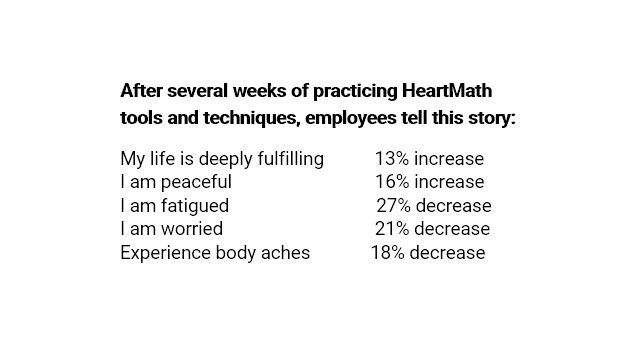

Our LiveWell team trained over 1,000 employees. We celebrate the dramatic improvements in our staff’s quality of life. They feel less fatigued, less worried, have fewer body aches and pains, are more at peace and describe their lives as more fulfilling. All HeartMath participants earn 150 LiveWell Points.
Delays in GI lab schedule – had to go tell room full of families in waiting room about the 1.5 hour delay. I used Quick Coherence Technique, calmed down, spoke clearly and was relaxed. Families took it well and I walked away thinking: that went well…
HeartMath Organizational Programs:
Leadership programs, trainer certifications, patented technology, research measurements, sustainability modules
We listen to your needs and suggest program components that fit your culture and budget.
Please send me more information on the HeartMath Organizational Programs
Or Call 831-338-8722

